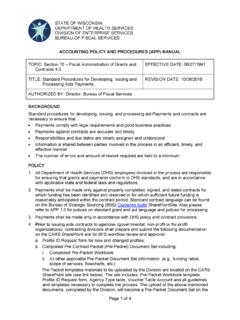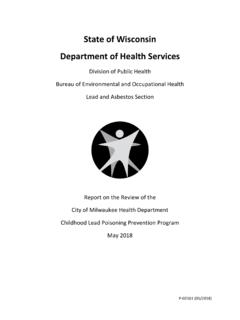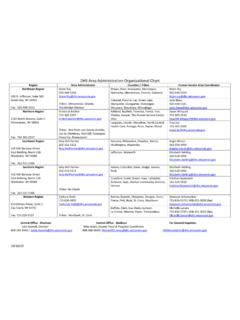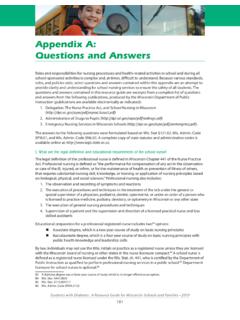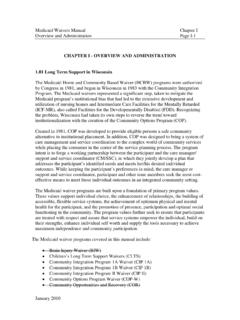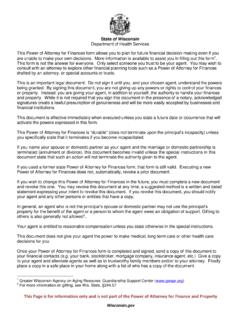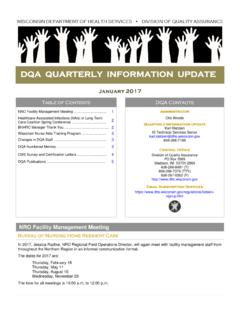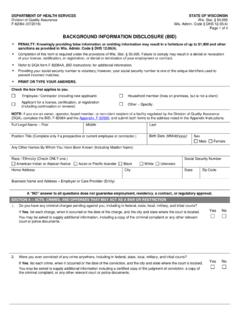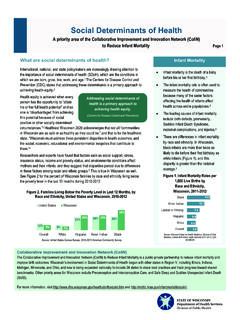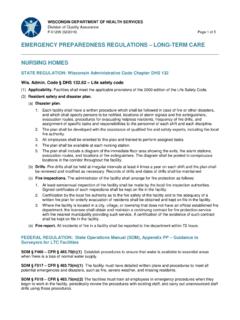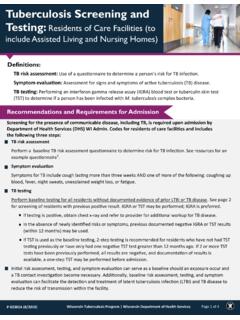Transcription of Tuberculosis Screening and Testing: Health Care Personnel ...
1 Screening and testing Upon Hire TB risk assessment Perform a baseline TB risk assessment questionnaire for HCP and caregivers to determine risk for TB infection. See resources for an example questionnaire1. Symptom evaluation Symptoms for TB include cough lasting more than three weeks AND one of more of the following: coughing up blood, fever, night sweats, unexplained weight loss, or fatigue. TB testing Perform baseline testing for all HCP and caregivers without documented evidence of prior LTBI or TB disease. See page 2 for Screening of staff with previous positive results. IGRA or TST may be performed; IGRA is preferred. See Figure 1 on page 2 for interpretation of test results for low risk individuals.
2 If testing is positive, obtain chest x-ray and refer HCP or caregiver to provider for additional workup for TB disease. In the absence of newly identified risks or symptoms, previous documented negative IGRA or TST results (within 12 months) may be used. If TST is used as the baseline testing , 2-step testing is recommended for HCP and caregivers who have not had TST testing previously or have only had one negative TST test greater than 12 months ago. If 2 or more TST tests have been previously performed, all results are negative, and documentation of results is available, a one-step TST may be performed before hire. Initial risk assessment, testing , and symptom evaluation can serve as a baseline should an exposure occur and a TB contact investigation become necessary.
3 Additionally, baseline risk assessment, testing , and symptom evaluation can facilitate the detection and treatment of latent Tuberculosis infection (LTBI) and TB disease in HCP before employment begins and reduce the risk of transmission to patients and other HCP. P-02382 (8/2019) wisconsin Tuberculosis Program | wisconsin department of Health services Page 1 of 3 Tuberculosis Screening and testing : Health care Personnel (HCP) and Caregivers (including assisted living staff) TB risk assessment: Use of a questionnaire to determine a person s risk for TB infection. Symptom evaluation: Assessment for signs and symptoms of active Tuberculosis (TB) disease. TB testing : Performing an interferon gamma release assay (IGRA) blood test or tuberculin skin test (TST) to determine if a person has been infected with M.
4 Tuberculosis bacteria. Definitions: Screening for latent TB infection (LTBI) and TB disease should be performed before assumption of duties in which HCP and caregivers will have direct contact with patients and includes the following three steps: Figure 1. Interpretation of Test Results in Low Risk Individuals Annual (Serial) testing for HCP Not Recommended TST positive in HCP who is asymptomatic and unlikely to be infected IGRA positive in HCP who is asymptomatic and unlikely to be infected Repeat test using IGRA. Wait 3-6 months to avoid potential boosting from TST. * Repeat testing using either IGRA or ,3 Numeric values may also be considered. TB antigen minus nil values between should be retested.
5 1. HCP should be considered infected with M. Tuberculosis only if both the first and second tests are ,3 2. Weigh risks and benefits of treatment with risk for infection 3. Contact the WI TB Program for consultation Dorman SE et al. AJRCCM 2014; 189(1) online supplement. Lewinsohn et al., CID 2017; 64(2): 111-5, figure 2. Thanassi et al., 2012; Pulm Med 291294. *Van Zyl-Smit et al. AJRCCM 180;49 2009. OR Screening and testing with History of Positive IGRA or TST HCP and caregivers should be educated on the signs and symptoms of TB disease and risk for disease progression, and should seek medical evaluation if these occur. Treatment for LTBI is strongly recommended to reduce the risk of progression to active TB disease.
6 Individuals with a history of TB or LTBI will likely have positive IGRA and TST results for their lifetime. P-02382 (8/2019) wisconsin Tuberculosis Program | wisconsin department of Health services Page 2 of 3 HCP and caregivers that have documented positive IGRA or TST results or documented treatment for TB or LTBI do not need baseline TST or IGRA. Obtain a baseline chest x-ray and symptom evaluation. Previous baseline radiographs (within six months) may be used for asymptomatic workers. Chest x-ray should be repeated if HCP or caregiver is symptomatic. Serial follow-up chest x-rays are not recommended, however, an annual TB risk assessment questionnaire and symptom evaluation should be administered.
7 For those determined to have been exposed, perform evaluation for signs and symptoms of TB disease. For those who previously had negative results, administer an IGRA or TST . Do not perform IGRA or TST for persons with previous positive results. Repeat symptom evaluation and IGRA or TST at 8-10 weeks after the end of exposure if the initial result was negative. If the symptom evaluation or the initial or the 8-10 week follow-up IGRA or TST is positive, evaluate the HCP for TB disease including performing a chest x-ray. HCP should be educated on the signs and symptoms of TB disease and should seek medical evaluation if these occur. testing After a TB Exposure Event HCP and caregivers should not undergo routine serial (annual) TB testing at any interval after baseline unless there is known exposure or evidence of ongoing transmission.
8 P-02382 (8/2019) wisconsin Tuberculosis Program | wisconsin department of Health services Page 3 of 3 Resources 1. wisconsin Tuberculosis Program TB Risk Assessment Questionnaire. 2. Centers for Disease Control and Prevention (2019). Tuberculosis Screening , testing , and treatment of Health care Personnel : Recommendations from the National Tuberculosis Controllers Association and CDC, 2019. MMWR 2019: 68(No. 19). 3. Centers for Disease Control and Prevention (2017). Official American Thoracic Society/Infectious Diseases Society of America/Centers for Disease Control and Prevention clinical practice guidelines: Diagnosis of Tuberculosis in adults and children, Clinical Infectious Diseases, 64(2): 111-5.
9 Retrieved from Annual (Serial) Training and Screening HCP and caregivers should be educated annually about TB, including information about TB risk factors, the signs and symptoms of TB disease, and TB infection and control policies and procedures. The wisconsin Division of Health TB Program recommends that facilities should include a TB screen for each individual using a risk assessment questionnaire as part of annual training as a standard of practice.
